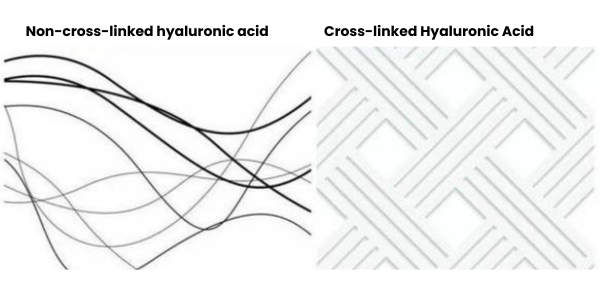
Hyaluronic acid can be found in many different forms and has applications in beauty and medicine. One type, called cross-linked hyaluronic acid, is considered the finest quality for high-end beautification due to its unique structure and properties. So, what is so different with crosslinked hyaluronic acid?
What Is Cross-linked Hyaluronic Acid
Cross-linked hyaluronic acid is a modified form of hyaluronic acid where the molecules are chemically crosslinked to form a three-dimensional network. Traditional hyaluronic acid exists as single chains, which are quickly degraded by hyaluronidase in the body. Through the use of crosslinking agents (such as BDDE), individual molecules are bonded into a stable network, significantly enhancing its resistance to degradation and prolonging its lifespan.
Stable Three-Dimensional Structure
The three-dimensional network structure of crosslinked hyaluronic acid offers several unique advantages. This structure not only increases the material\u2019s physical strength and viscoelasticity but also retains more water, maintaining the gel’s volume and shape. More importantly, the structural stability greatly slows its metabolic breakdown in the body, allowing it to last for months or even years, making it an ideal choice for long-term medical and cosmetic applications.

Fig1. Non-cross-linked hyaluronic acid vs. cross-linked hyaluronic acid
Applications of Crosslinked Hyaluronic Acid
Cross-linked hyaluronic acid is one of the major raw materials in beauty and medical gels. This three-dimensional network will enable the product to keep its shape once injected and counteract forces of deformation. Being a base material, it holds unlimited possibilities for developing a gel that could be fitted for specific needs.
The hyaluronic acid that is crosslinked finds very extensive applications in facial filling for rhinoplasty, lip augmentation, and hollow areas in the face. This high-viscoelastic material offers great stability, and because of these properties, this material guarantees a long-lasting shaping effect after injection with a very natural appearance.
The star product for anti-wrinkle treatments is the crosslinked hyaluronic acid. Injected into the area with wrinkles, it fills fine lines and restores skin elasticity, hence greatly improving facial contours and skin condition. Compared to non-crosslinked hyaluronic acid, it has a longer effectiveness in anti-wrinkle effects.
Conclusion
With its unique three-dimensional structure and exceptional performance, cross-linked hyaluronic acid has become a cornerstone in the medical and cosmetic fields. Whether as a raw material for gels or for facial filling and anti-wrinkle treatments, it demonstrates remarkable value and advantages.
Stanford Chemicals Company (SCC) is at the forefront of hyaluronic acid development, offering sodium hyaluronate powder in various molecular weights. For more information or specific applications, please visit our homepage.
